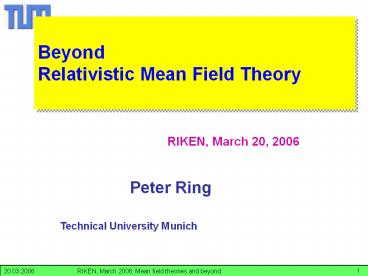RIKEN-06 - PowerPoint PPT Presentation
Title:
RIKEN-06
Description:
Scissor mode in 20Ne. RIKEN, March 2006: Mean field theories and beyond. 20.03.2006 ... Scissor in Ne-20 d?. Scissor mode in 20Ne at E1 =5.66 MeV. n. p. NL3 ... – PowerPoint PPT presentation
Number of Views:40
Avg rating:3.0/5.0
Title: RIKEN-06
1
RIKEN-06
Beyond Relativistic Mean Field Theory
RIKEN, March 20, 2006
Peter Ring
Technical University Munich
2
Content
3
Walecka model
Covariant density functional theory
Nucleons are coupled by exchange of mesons
through an effective Lagrangian (EFT)
(J?,T)(0,0)
(J?,T)(1-,0)
(J?,T)(1-,1)
Rho-meson isovector field
Omega-meson short-range repulsive
Sigma-meson attractive scalar field
4
Point-coupling model
Point-Coupling Models
s
?
d
?
J1, T1
J1, T0
J0, T1
J0, T0
Manakos and Mannel, Z.Phys. 330, 223
(1988) Bürvenich, Madland, Maruhn, Reinhard, PRC
65, 044308 (2002
5
Density dependence
Effective density dependence
non-linear potential
NL1,NL3..
Boguta and Bodmer, NPA. 431, 3408 (1977)
density dependent coupling constants
R.Brockmann and H.Toki, PRL 68, 3408
(1992) S.Typel and H.H.Wolter, NPA 656, 331
(1999) T. Niksic, D. Vretenar, P. Finelli, and P.
Ring, PRC 56 (2002) 024306
g ? g(r(r))
DD-ME1,DD-ME2
6
Density dependence
Three relativistic models
Meson exchange with non-linear meson couplings
Boguta and Bodmer, NPA. 431, 3408 (1977)
NL1,NL3,TM1,..
Meson exchange with density dependent coupling
constants
R.Brockmann and H.Toki, PRL 68, 3408 (1992)
DD-ME1,DD-ME2
Point-coupling models with density dependent
coupling constants
Manakos and Mannel, Z.Phys. 330, 223 (1988)
PC-1,.
7
static RMF eq.
The static limit (with time reversal)
for the nucleons we find the static Dirac equation
for the mesons we find the Helmholtz equations
8
TDRMF Eq.
Time dependent mean field theory
No-sea approxim. !
and similar equations for the ?- and A-field
9
Monopole motion
breathing mode 208Pb
K8211
K8271
K8355
10
RRPA
Relativistic RPA for excited states
drph, drah
Small amplitude limit
ground-state density
drhp, drha
RRPA matrices
the same effective interaction determines the
Dirac-Hartree single-particle spectrum and the
residual interaction
11
ah-configurations
Selfconsistent Symmetries
Eah -1200 MeV
ah
ltphV?ahgt 0 for vector mesons ltphVsahgt
? 0 for scalar mesons
- size of matrix.element
- the same quantum numbers possible
- large degeneracy
P. Ring et al., NPA 694 (2001) 249
12
Pb GMR/GDR
DD-ME2
G.A. Lalazissis et al, PRC 71, 024312 (2005)
13
Sn GDR DD-ME2
DD-ME2
IV-GDR in Sn-isotopes
G.A. Lalazissis et al, PRC 71, 024312 (2005)
14
IV-GDR in Ne-20 (dots)
IV-GDR in deformed 20Ne
NL3
15
IV-GDR in O-16 (test)
IV-GDR in 16O
16
BM1 strength in Ne-20
Scissor mode in 20Ne
NL3
17
Scissor in Ne-20 d?
Scissor mode in 20Ne at E15.66 MeV
p
n
Transition density d?(r,z)
NL3
18
Spurious modes in Ne-20
Spurious modes in 20Ne
1_
Ephh?
NL3
19
pygmy-resonance in Ne-26
Pygmy-Resonance in deformed 26Ne
GANIL
THEORY
preliminary
20
Beyond Mean Field
Beyond Mean Field
Conservation of symmetries Projection before
Variation Motion with large amplitude
Generator Coordinates Coupling to Collective
Vibrations - shifts of single particle
energies - decay width of giant resonances
J. Sheikh and P. Ring, Nucl. Phys. A665 (2000)
71 E. Lopes, PhD thesis, TU München T. Niksic, D.
Vretenar, and P. Ring, Phys. Rev. C (2006) in
print E. Litvinova and P. Ring, Phys. Rev. C
(2006) in print
21
decomposition of Ligt
Halo wave function in the canonical basis
CN2
N
2
4
6
8
10
22
projected DFT
Projected density functionals
projected denstiy functional
density dependent interactions !!!
23
projected Ne-chain
Halo-formation in Ne-isotopes
pairing energies
binding energies
rms-radii
L. Lopes, PhD Thesis, TUM, 2002
24
GCM-method
Generator Coordinate Method (GCM)
Constraint Hartree Fock produces wave functions
depending on a generator coordinate q
GCM wave function is a superposition of
Slaterdeterminants
Hill-Wheeler equation
with projection
25
potential surface Hg-194
Energy surfaces in 194Hg
26
details of norm-matrix in GCM
Norm matrix in GCM
27
unprojected GCM N-dependence
unprojected GCM (N-dependence)
28
unprojected GCM q-steps
unprojected GCM (?q-dependence)
29
GCM-wavefunctions Hg-194
GCM wave functions
30
J-projected energy surfaces Hg-194
31
potential surface Mg-32
Energy surfaces in 32Mg
32
single-particle spectra Mg-32
single particle spectra
33
J-projected surfaces Mg-32
J-projected potential surfaces
34
GOA Mg-32
Gaussian operlap approximation
35
J-projected Norm Mg-32
J-projected norm
36
rotational energy correction Mg-32
rotational energy corrections
37
J-projected GCM spectra Mg-32
J-projected GCM-spectrum
38
JGCM-wavefunctions Mg-32
J-projected GCM wave functions
39
Particle-Vibrational Couplingenergy dependent
self-energy
single particle strength
40
fragmentation in 209-Bi
Distribution of single-particle strength in 209Bi
41
(No Transcript)
42
Width of Giant Resonances
The full response contains energy dependent parts
coming from vibrational couplings.
Self energy
g phonon amplitudes (QRPA)
ph interaction amplitude
43
Decay-width of the Giant Resonances
E1 photoabsorption cross section
44
GMR in RRPARRPA-PC
GMR in RRPA and RRPA-PC
45
GDR in Pb, RRPA-RRPA-PC
The Giant Dipole Resonance in 208Pb
46
GDR in Sn, RRPARRPA-PC
The Giant Dipole Resonance in 132Sn
47
Energy and Width of GDR
GDR comparison with experiment
48
Conclusions 1 -------
Conclusions
Deformed RPA- and QRPA calculations are now
possible. They are very important for nuclei far
from stability In transitional nuclei we can do
Variation after Projection a new method allows
this also in relativistic calculations. Configura
tion mixing is possible by GCM calculations -
they require angular momentum projection - the
numerical effort is large - restriction to axial
symmetry at the moment essential The admixture
of 2p-1h or 2p-2h states is possible by particle
vibrational coupling (PVC). - this leads to
fragmentation of the single particle states -
enhanced level density at the Fermi surfac -
enhanced width of giant resonances
49
-----Open Problems ------
Open Problems
Simpler parametrizations - point coupling
- simpler pairing Improved energy
functional - Fock terms and tensor forces
- why is the first order pion-exchange
quenched? - is vacuum polarization important
in finite nuclei Conceptual problems -
what is form of the functional, if we go beyond
mean field? - density dependence and
projection (Egido-poles) - density dependence
and symmetries (RPA)































